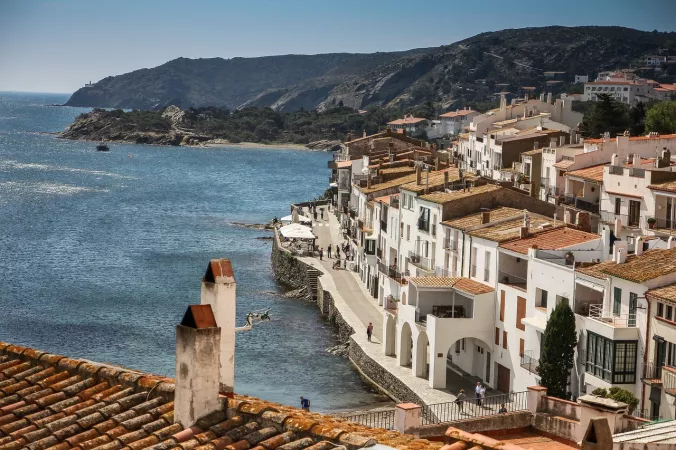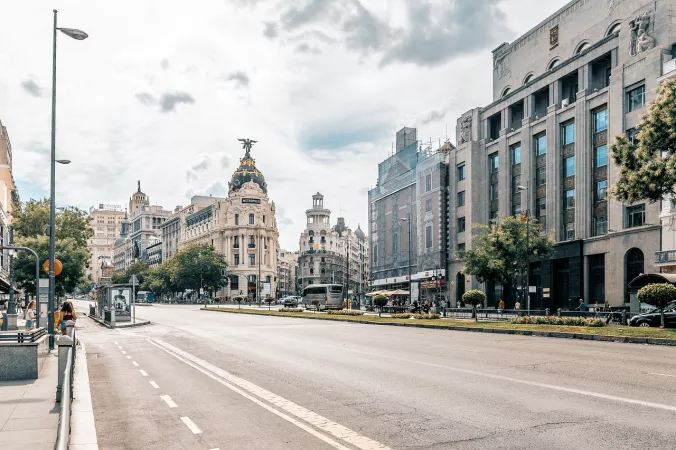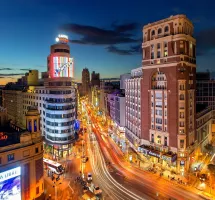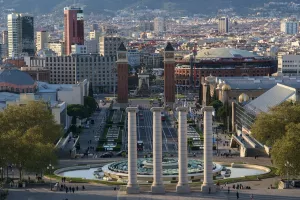
Spain
Duration
10 to 14 Days
10 to 14 Days
Best time to visit
May-Jun, Sep
May-Jun, Sep
Theme
Hill Station, Beaches, Heritage
Hill Station, Beaches, Heritage
Spain Travel Guide
Spain, located in southwestern Europe, is famous for its rich history, diverse geography, and vibrant culture. Known for flamenco music and dance, bullfights, fantastic beaches, and plenty of sunshine, Spain is a popular destination for tourists from all over the world.Top Attractions in Spain
- La Sagrada Familia in Barcelona
- The Alhambra in Granada
- The Prado Museum in Madrid
- The Running of the Bulls in Pamplona
- The Mosque-Cathedral of Cordoba
Spain is Famous for
Spectacular architecture, delicious cuisine, and vibrant festivals.Top Attractions in Spain
- Exploring the historic streets of Toledo
- Relaxing on the beaches of Costa del Sol
- Sampling tapas in San Sebastian
- Visiting the Guggenheim Museum in Bilbao
- Partying at the lively festivals in Valencia
What's Great about Travelling to Spain?
- Rich history and culture
- Beautiful beaches and landscapes
- Delicious food and wine
- Warm and welcoming locals
What's Not So Great about Travelling to Spain?
- High tourist crowds in popular areas
- Language barrier for non-Spanish speakers
- Pickpocketing in touristy areas
- Hot summers in some regions
Travel Tips for Spain
- Check visa requirements before traveling
- Use public transportation or taxis in cities
- Stay aware of your belongings in crowded areas
- Try local cuisine and wines
Important Spain trip information
- Ideal Duration: Spend at least 2 weeks to explore the main attractions.
- Best Time to Visit: Spring and fall for pleasant weather.
- Nearby Airports and Railway Stations: Major airports in Madrid, Barcelona, and Valencia. High-speed trains connect major cities.
Top 9 Places to visit in Spain
Per Person
1,68,700
*EXCLUDING APPLICABLE TAXES 5.0 Ratings
( 20 Reviews )
( 20 Reviews )
Per Person
2,52,000
*EXCLUDING APPLICABLE TAXES 5.0 Ratings
( 20 Reviews )
( 20 Reviews )
Per Person
2,04,500
*EXCLUDING APPLICABLE TAXES 5.0 Ratings
( 20 Reviews )
( 20 Reviews )
Per Person
1,95,500
*EXCLUDING APPLICABLE TAXES 5.0 Ratings
( 20 Reviews )
( 20 Reviews )
Total
3,14,000
*EXCLUDING APPLICABLE TAXES 5.0 Ratings
( 20 Reviews )
( 20 Reviews )
Per Person
1,62,900
*EXCLUDING APPLICABLE TAXES 5.0 Ratings
( 20 Reviews )
( 20 Reviews )
FAQ's on Spain
Q1: What is the best time to visit Spain?
The best time to visit Spain is during the spring (March to May) and fall (September to November) when the weather is mild, and tourist crowds are less. Summer (June to August) is popular for beach destinations, but it can be very hot. Winter (December to February) is ideal for skiing in the Pyrenees or Sierra Nevada. Festivals like La Tomatina in August or the Running of the Bulls in July are also popular events to experience.
Q2: Do I need a visa to travel to Spain?
Citizens of the EU, EEA, and many other countries do not need a visa for short stays in Spain. However, it's essential to check the specific visa requirements based on your nationality and the purpose of your visit. Make sure your passport is valid for at least three months beyond your planned departure date.
Q3: What are the must-visit attractions in Spain?
Spain is home to iconic attractions like the Sagrada Familia in Barcelona, Alhambra in Granada, Prado Museum in Madrid, and the vibrant streets of Seville. Don't miss the stunning beaches of Costa del Sol, the historic city of Toledo, or the picturesque island of Mallorca. Explore the Camino de Santiago pilgrimage route or enjoy the unique architecture of Antoni Gaudí.
Q4: Is Spain a safe place to travel?
Spain is generally a safe country for travelers. However, like any destination, tourists should be cautious of pickpocketing in crowded areas and tourist hotspots. Avoid demonstrating wealth in public and be aware of your surroundings, especially at night. It's advisable to use registered taxis and be cautious of scams targeting tourists. Emergency services are available by dialing 112.
Q5: What is the local currency in Spain and can I use credit cards?
The local currency in Spain is the Euro (€). Credit and debit cards are widely accepted in major establishments, but it's advisable to carry some cash for smaller purchases and in more local areas. ATMs are widely available in cities and towns for convenient currency exchange. Notify your bank before traveling to avoid any issues with card transactions.
Q6: What is the local cuisine like in Spain?
Spanish cuisine is renowned for its diversity and flavors. Enjoy tapas, paella, gazpacho, churros, and traditional dishes like patatas bravas and tortilla española. Seafood lovers can savor fresh catches along the coast, while meat enthusiasts can indulge in jamón ibérico and chorizo. Don't forget to try regional specialties like pintxos in the Basque Country and horchata in Valencia. Vegetarian and vegan options are also available in most restaurants.
Q7: What transportation options are available in Spain?
Spain offers an extensive transportation network, including high-speed trains (AVE), buses, metro systems in major cities, and domestic flights. Renting a car is a popular option for exploring rural areas and small towns. Taxis are readily available, especially in urban areas, and ride-sharing services like Uber operate in some cities. Public transportation is efficient and a cost-effective way to get around.
Q8: Are there any cultural norms or etiquette I should be aware of when visiting Spain?
When visiting Spain, it's important to respect local customs and etiquette. Spaniards typically greet with a kiss on each cheek among friends and family. Tipping is appreciated but not obligatory, with 5-10% being customary in restaurants. Respect local dining hours, as lunch is eaten around 2 pm and dinner around 9 pm. Dress modestly when visiting religious sites, and avoid discussing sensitive topics like politics or religion. Enjoy the siesta tradition in the afternoon when many shops close for a break.
Q9: I am a travel agent. How can I buy travel leads of Spain?
Register yourself as a travel agent at agents.tripclap.com and then you can buy travel leads to Spain once your account is approved. For more details contact our support team at +91-8069186564 or support@tripclap.com






